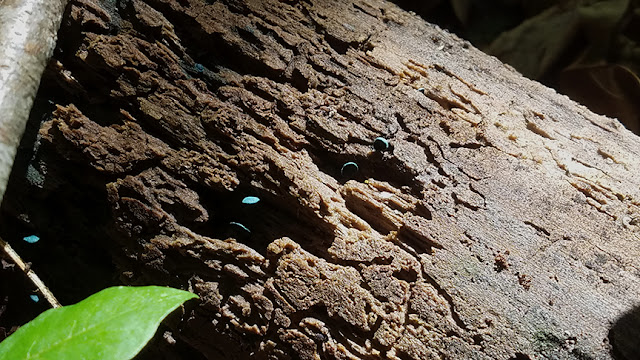 | |
| Wild mushrooms in the woods. |
Me photographing and picking mushrooms (photo by Jeanne Gren) |
| Yellow-cap Collybia (Gymnopus subsulphureus) |
Last Saturday I took a workshop with Margaret Saylor, who specializes in painting mushrooms, at Oak Spring Gardens. In the morning, the class foraged around the fields and woods on the grounds surrounding our classroom to find our material. Fortunately, it has been a wet summer, and there was a wealth of unusual fungi to find. The two photos above are the same mushroom, the yellow color doesn't show up as much in the first.
 |
| My mushroom sketches from the class |
I was hoping to find something colorful, and was not disappointed. Identifying the mushrooms correctly is another matter! Even with the help of field guides, mushrooms have so many variations in form and color, it's very difficult to make a definite identification. The cluster of yellow-capped ones I picked for my sketch on the far right I believe may be the Yellow-capped Collybia (Gymnopus subsulphureus), at least that is the closest resemblance I could find.
The middle sketch was started in situ while squatting near an innoculated log, but I couldn't read the label so I have no idea what species it is. It's definetly not an oyster mushroom, perhaps a shiitake? A huge slug was eating it, so I wasn't about to pick that one.
From previous experience I recognized the mushroom sketched on the left
as a stinkhorn right away--I've come across this type of fungus in my
garden a few times before, growing from spores in the commercial mulch I
buy. The ones I've come across before are Mutinus elegans, a species which has a shiny brown cap on a spongy orange stem that resembles the male organ. Some folks call it the dog's prick stinkhorn.
 |
| Perhaps a squid stinkhorn? (Pseudocolus fusiformis) |
Some one else in the class had picked this stinkhorn mushroom and brought it in, but found the smell of it so unpleasant, she couldn't stand being near it long enough to sketch it. Fortunately for me, my nose was completely stuffed up on that day and I couldn't smell a thing, so it was perfect for me--although after a while of sketching it, the smell did start to break through to even my stuffy nose, but I didn't find it nasty, more sort of medicinal, but that was me... I wish I could have seen the stinkhorn when it was intact, to determine if it is what I suspect, the Stinky squid stinkhorn (Pseudocolus fusiformis).
The "egg" from which the fungus sprouts is larger and more irregular in shape on this one than the Mutinus elegans ones I've seen in my garden. These fungi disintegrate so quickly, it was time to dispose of it at the end of the class. The workshop was great fun for all, but over much too soon. I did manage to bring home a few specimens that I though might keep a bit longer. I worked on these sketches during the past few days.
Among the specimens I brought back were a couple of Hemlock Polypores (Ganoderma tsuga) that had dried nicely. One specimen in particular I though was spectacular, an accretion of mushrooms that looked so cool, I just had to sketch it!
 |
| My collection of Hemlock Polypores (Ganoderma tsuga) |
 |
| My sketch of the weirdly-shaped Hemlock Polypores |
I love the bright colors of the one stem with the whitish cap and the wine-red lateral stems with the incrustations of earth and mulch! I now have three of these weird fungi in my collection--they dry really well and last a long time, although the bright colors may fade eventually.
 | |
| Two-color Boletes. |
Another colorful mushroom I found were these small Two-colored Boletes (Baorangia bicolor) right by the path through the woods. I've seen these before, but didn't know what they were until I checked with my field guide. I included them in my sketchbook page with the other Hemlock Polypore. I wish I'd been able to sketch them when they were fresher and much brighter in color.
 |
| White colored mushrooms (Leucoagaricus americanus?) |
The mushrooms above I haven't been able to identify with any certainty--these could be two different species or the same species at different stages of development. Some mushroom caps start out being conical (convex) and the caps eventually grow concave. Here are some photos of these.
 |
| Reddening Lepiota (Leucoagaricus americanus)? early stage. |
 |
| Same species, more mature stage. |
The shagginess of the cap in these mushrooms leads me to believe these may be the Reddening Lepiota (Leucoagaricus americanus) I sketched on the left. The other mushroom sketched on the right (two views) seems to have a smoother cap and more delicate gills, it could be the same species but more likely it's something else called the Fawn or Deer mushroom (Pluteus cervinus).
 |
| Margaret Saylor's mushroom on vellum. |
I leave you with this exquisite small painting that our instructor, Margaret Saylor, was working on. It's watercolor on vellum using classic dry brush techniques--lovely work!
It's raining today, and I'm hoping this will bring forth a whole lot of fresh mushrooms sprouting in the woods--can't wait to see what else is out there to be discovered!


















































